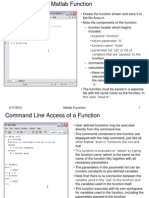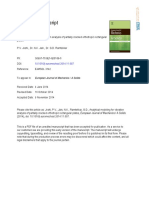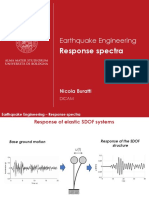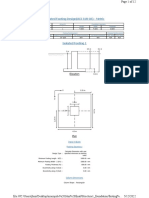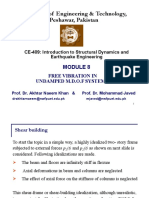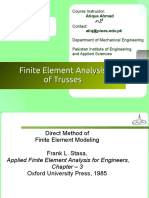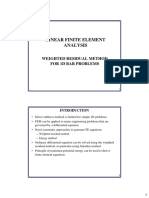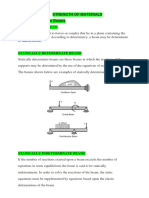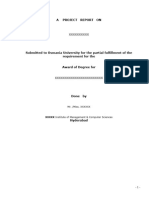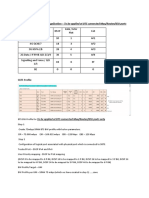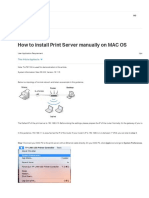Advance Physics Letter
________________________________________________________________________________
Beam Analysis in Matlab
(For simply supported & Cantilever; For Point Load & UDL)
1
Gulab Pamnani; 2Dageshwar Singh Rajput; 3Nikhil Tiwari;4Amit Gajendra
Assistant Professor, Department of Mechanical Engineering, Bhilai Institute of Technology, Raipur, India
2,3,4
U. G. Student, Department of Mechanical Engineering, Bhilai Institute of Technology, Raipur, India
Email: gulabpamnani@gmail.com
Abstract- Beam being an important member of any structure
and bears heavy loads and hence before using beams one have
to be very sure about its strength and deflection. Industrial
support beams all have different support and structural
properties and are used in various types of design. Beam
stresses and deflections should be within the material
allowable limits and therefore analysis of beam design is
essential.
In present work a software called MATLAB is used to
analyse beam design. MATLAB is extensively used for
scientific & research purposes. It is accurate & also has a
number of built in functions which makes it versatile. This
requirement of analysis meets with the Matlab software. This
gives the package for high-performance numerical
computation and visualization.
has a value of Wn/m. For any given length x meters, the
total load is wx Newton and this is assumed to act at the
centre of that length.
Point Load
I. INTRODUCTION
1. Introduction of beam
A beam is a structure loaded by forces acting
transversely (sideways) to its length and this make the
beam bend. Beams may be supported across a span in
various ways as show.
Simply Supported Beam
Uniformly Distributed Load
Fig-2 Types of Load
When a beam bends, one side is stretched and goes into
tension and the other side is compressed. It follows that
there is a layer (called the neutral layer) somewhere in
the middle that is neither stretched nor compressed. It is
always the tension that causes the material to fail and if
the beam is made of something brittle like concrete, it
will break very easily.
Fixed Beam
Cantilever Beam
Fig -1 Types of Beam
Bending is the most severe form of loading that can be
applied. Think how easy it is to break a something like a
ruler by bending is as opposed to stretching it or
shearing it. The loads (forces) may be applied at a point
(point loads) or spread along a length. For example the
weight of a beam is spread along the length and this is
an example of a uniformly distributed load (UDL).
A point load is shown as a single arrow and acts at a
point. Uniform loads are shown as a series of arrows and
Fig -3 Bending
We need to study the relationship between the stress and
the things that affect it. The three part formula shown
next (the bending formula) expresses this and we need to
study this closely.
M E
= =
I
y R
II.CLASSIFICATION OF BEAM
The beam can be attached in any structure through
various ways and hence their name has given from that
e.g. simply supported beam, cantilever beam,
ISSN (Print) : 2349-1094, ISSN (Online) : 2349-1108, Vol_1, Issue_2, 2014
27
�Advance Physics Letter
________________________________________________________________________________
overhanging beam & fixed beams. These beams to be
make for their ability to sustain the different kind of load
at different parts or the requirement of the design. These
beams are to selected first with the proper arrangement
and thus the different section can be chooses namely as
Rectangular Section, I-section, C-section, L-section, Tsection. These sections have different geometries and
hence different Centroidal axis which further gives its
different area moment of inertia. The dimensions of the
beam may depend upon requirement or the possible case
of beam design.[5]
The above elements help to figure out the shear forces
and bending moment with the help of loads. The loads
could be of various kinds as UDL, VDL, Pt. Load
&Mixed load. These loads are applying on the beam
because of various mechanical processes or simply the
use of beams in loadings and offer a direct
connection.[2]
/ division
^ exponentiation
.* term-by-term multiplication
./ term-by term division
. term-by term exponentiation
>> MATLAB prompt
IV. PROCESS FLOW CHART- BEAM
ANALYSIS
Specify design characteristic
of beam
Select type of beam and load
No. of loads
Calculation for the centroidal
axis of beam
Calculation for area momentof
inertia about centroidal axis
Calculation for reactions at
supports
Fig 4.Classification of Beam
III. ABOUT MATLAB
MATLAB (MATrixLABoratory) is an interactive
system for matrix-based computation, designed for
scientific and engineering use. MATLAB is a high
performance language for technical computing. It
integrates computation, visualization, and programming
in an easy-to-use environment where problems and
solutions are expressed in familiar mathematical
notations. Typically uses include: Math and computation
Algorithm development modeling, simulation, and
prototyping
Data
analyzing,
exploration
and
visualization Scientific and engineering graphics
Application development including graphical user
interface building MATLAB is a software package for
high-performance
numerical
computation
and
visualization. It provides an interactive environment
with hundreds of built-in functions for technical
computation, graphics, and animation. Best of all, it also
provides easy extensibility with its own high-level
programming language. MATLAB is an interactive
system whose basic data element is an array that does
not requires dimensioning. This allows solving many
technical computing problems especially those with
matrix and vectoring foundation.
3.1 Matrix Operators
MATLAB has several operators for our use
. + addition
- substraction
* matrix multiplication
Calculation for shear force
Calcultion for bending moment
Choose maximum bending
moment
Maximum working stress of
beam
Find out F.O.S
If F.O.S. is within
the limit
If F.O.S. is out
of the limit
Design is safe
Design is fail
Flow Chart.1
ISSN (Print) : 2349-1094, ISSN (Online) : 2349-1108, Vol_1, Issue_2, 2014
28
�Advance Physics Letter
________________________________________________________________________________
V. ANALYSIS OF BEAM
This indicates that the stress in a beam depends on the
bending moment and so the maximum stress will occur
where the bending moment is a maximum along the
length of the beam. It also indicates that stress is related
to distance y from the neutral axis so it varies from zero
to a maximum at the top or bottom of the section.
5.1. Matlab Output Window
The Matlab program we designed takes the input values
as shown in the below figure and the logic that we have
formulated gives the output values such Maximum
deflection and the remaining required parameters with
minimum input variables.
It also gives the shear force and bending moment
diagram of the beam with given values and also tells
weather the design of the beam is safe or not.
The input values given such as no. of loads, value of
loads, length of beam, FOS etc. and the output values
such as deflection and other parameters are shown as
below.
5.1.1Analysis for simply supported with point load
Figure.5.1.1a Inputs to Matlab code
The output beam parameters we attain through this are as followsReaction Forces
Deflections at different points
Max. Deflection
Bending Moment Diagram
Shear Force Diagram
ISSN (Print) : 2349-1094, ISSN (Online) : 2349-1108, Vol_1, Issue_2, 2014
29
�Advance Physics Letter
________________________________________________________________________________
Figure.5.1.1b Output of the code
a) Shear Force Diagram for Simply Supported Beam fromMatlab Code
The generated shear force diagram using Matlab is as shown below. It gives the diagrammatic representation of shear
forces at different points of beam.
Figure.5.1.1c Shear Force Diagram for Simply Supported Beam Point Load
b) Bending Moment Diagram for simply supported beam with point load
The generated shear force diagram using Matlab is as shown below. It gives the diagrammatic representation of bending
moments at different points of beam.
Figure.5.1.1dBending Moment Diagram for Simply Supported Beam Point Load
ISSN (Print) : 2349-1094, ISSN (Online) : 2349-1108, Vol_1, Issue_2, 2014
30
�Advance Physics Letter
________________________________________________________________________________
5.1.2 Simply Supported Beam with Uniformly Distributed Load
Figure. 5.1.2a Inputs to Matlab code
The output beam parameters we attain through this are as follows
Reaction Forces
Deflections at different points
Max. Deflection
Bending Moment Diagram
Shear Force Diagram
ISSN (Print) : 2349-1094, ISSN (Online) : 2349-1108, Vol_1, Issue_2, 2014
31
�Advance Physics Letter
________________________________________________________________________________
Figure.5.1.2b Output of the program
a) Shear Force Diagram for simply supported beam with UDL
The generated shear force diagram using Matlab is as shown below. It gives the diagrammatic representation of shear
forces at different points of beam.
Figure.5.1.2c Shear Force Diagram for Simply Supported Beam with UDL
b) Bending Moment Diagram for simply supported beam with UDL
The generated bending moment diagram using Matlab is as shown below. It gives the diagrammatic representation of
bending moments at different points of beam.
Figure.5.1.2d Bending Moment Diagram for Simply Supported Beam with UDL
5.1.3Analysis for Cantilever with Point Load
ISSN (Print) : 2349-1094, ISSN (Online) : 2349-1108, Vol_1, Issue_2, 2014
32
�Advance Physics Letter
________________________________________________________________________________
Figure 5.1.3a. Inputs given to Matlab Program
The output beam parameters we attain through this are as follows
Reaction Forces
Deflections at different points
Max. Deflection
Bending Moment Diagram
Shear Force Diagram
Figure.5.1.3b Output of the program
a) Shear Force Diagram for cantilever beam with point load
ISSN (Print) : 2349-1094, ISSN (Online) : 2349-1108, Vol_1, Issue_2, 2014
33
�Advance Physics Letter
________________________________________________________________________________
The generated shear force diagram using Matlab is as shown below. It gives the diagrammatic representation of shear
forces at different points of beam.
Figure.5.1.3c Shear Force Diagramfor Cantilever with Point Load
b) Bending Moment Diagram for cantilever beam with point load
The generated bending moment diagram using Matlab is as shown below. It gives the diagrammatic representation of
bending moments at different points of beam.
Figure.5.1.3d Bending Moment Diagram
5.1.4 Analysis for Cantilever with UDL
Figure.5.1.4a Inputs given to Matlab Program
The output beam parameters we attain through this are as follows
ISSN (Print) : 2349-1094, ISSN (Online) : 2349-1108, Vol_1, Issue_2, 2014
34
�Advance Physics Letter
________________________________________________________________________________
Reaction Forces
Deflections at different points
Max. Deflection
Bending Moment Diagram
Shear Force Diagram
Figure.5.1.4b Output of the program
a) Shear Force Diagram for cantilever beam with UDL
The generated shear force diagram using Matlab is as shown below. It gives the diagrammatic representation of shear
forces at different points of beam.
Figure.5.1.4c Shear Force Diagram
b) Bending Moment Diagram for cantilever beam with UDL
The generated bending moment diagram using Matlab is as shown below. It gives the diagrammatic representation of
bending moments at different points of beam.
Figure.5.1.4d Bending Moment Diagram
ISSN (Print) : 2349-1094, ISSN (Online) : 2349-1108, Vol_1, Issue_2, 2014
35
�Advance Physics Letter
________________________________________________________________________________
VI. CONCLUSION
[4]
A quick and efficient way of analyzing the beam design
is developed through MATLAB code which can be use
to solve beam design problems faster and errorless
Timoshenko, S.P. and Young, D.H. Elements of
strength of Materials (2003), East-West private
ltd. Page No. 111-135
[5]
Black, Paul H. &Adams, O. Eugene, Machine
design (2001), Tata McGraw-Hill. Page No. 120.
[6]
Singh, Dr. Sadhu, Strength of material (2013),
Tata McGraw-Hill. Page No. 429-434
REFERENCES
[1]
Matlab Software releases 2007b
[2]
Rajput, R.K. Strength of Materials (2007), S
Chand & Co Ltd, Page No. 310-312
[7]
Bhandari, V.B., Machine design (2006), Tata
McGraw-Hill. Page No. 204-206
[3]
Ryder, G.H. Strength of material (1989),
Macmillan Press Ltd., Page No. 153
[8]
Singh, Rudra Pratap Matlab Programming
(2004), Mathworks Inc.
ISSN (Print) : 2349-1094, ISSN (Online) : 2349-1108, Vol_1, Issue_2, 2014
36




